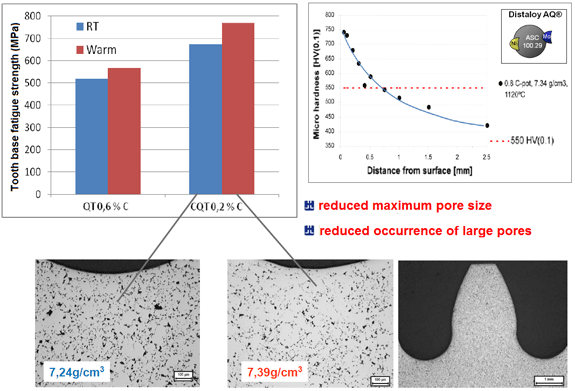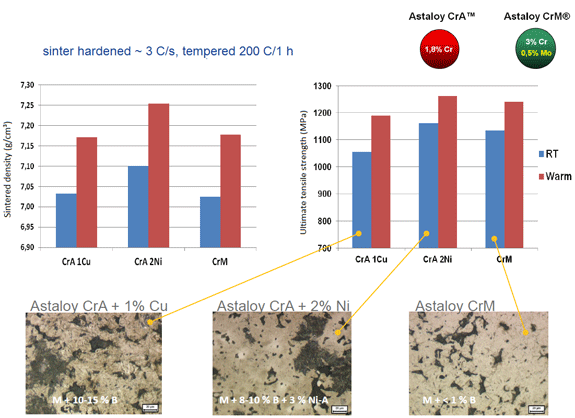2012 Hagen Symposium: The prealloyed powder concept to replace carbonyl nickel
In our previous reports from the 2012 Hagen Symposium, Dr Georg Schlieper discussed presentations highlighting the consequences of REACH legislation for manufacturers of sintered structural parts and the approach adopted by Hoeganaes Corporation to replace carbonyl nickel in PM steels using the master alloy concept.
In this article we report on presentations by Christophe Szabo of Höganäs GmbH and Robert Daniszewski of Pometon SpA, who discussed their concepts for the replacement of carbonyl nickel based on prealloyed powders.
Höganäs Astaloy CrA, Astaloy CrM, Distaloy AQ
Höganäs AB, Sweden, distributes its diffusion alloyed powders under the trade name Distaloy and prealloyed powders under the name Astaloy. In the first part of his presentation, Christophe Szabo outlined the ecological impact of PM technology in comparison with wrought steel technology.
The advantages of PM manufacturing, suggested Szabo, will undoubtedly lead to increased applications for powder metal parts as environmental issues become ever more important.
Höganäs’ strategy for high strength nickel-free structural parts is clearly in favour of using prealloyed powders rather than master alloys because they believe that the activity of alloying elements is better utilised. The company has invested a lot of effort to overcome the supposed lack in compressibility of prealloyed powders. Besides this, however, Höganäs further pursues the diffusion alloying concept, including the use of carbonyl nickel in its compositions.
The high performance alloys presented by Christophe Szabo are based on the grades Astaloy CrA (1.8% Cr), Astaloy CrM (3% Cr-0.5% Mo) and Distaloy AQ (0.5% Ni, 0.5% Mo).
Distaloy AQ was investigated with a carbon content of 0.2%C for case hardening (CQT) and 0.6%C for quench-and-temper (QT) heat treatment. Green densities at compaction pressures of 700 MPa were reported to be at 7.15 g/cm³ for cold compaction and 7.32 g/cm³ with warm compaction. After sintering at 1120°C/20 min under N₂/H₂ 90/10 atmosphere the densities were 7.24 g/cm³ (cold compaction) / 7.39 g/cm³ (warm compaction) for Distaloy AQ + 0.2%C and 7.15 g/cm³ / 7.3 g/cm³ for Distaly AQ + 0.6%C. Heat treatment was done at 860°C/20 min, oil quench and tempering at 200°C.
Particular interest was given to the properties required for gear applications (Fig. 1). The highest tooth base fatigue strength was achieved by warm compaction and case hardening. It was reported that warm compaction does not only lead to the highest densities, but also the maximum pore size is reduced and the occurrence of large pores is reduced as well.
The prealloyed grades were processed into three alloys, namely Astaloy CrA + 1% Cu + 0.65% C, Astaloy CrA + 2% Ni + 0.6% C, Astaloy CrM + 0.5% C. As shown in Fig. 2, these alloys can achieve sintered densities well above 7.0 g/cm³ and tensile strength values above 1000 MPa after sinter hardening with a cooling rate of roughly 3°C/s. Remarkably high fatigue strength values were also reported.
ECOSINT prealloyed powder grades developed by Pometon
The challenges imposed on the PM industry by economic, metallurgical and legal aspects stimulated Italian powder producer Pometon to develop a new family of Cr-Mo-Ni alloyed sinter hardening steel powders under the trade name ECOSINT.
By fully exploiting the synergy effects between the individual alloying elements it was possible to reach a critical cooling rate of as low as 0.45°C/s with a low total alloying content. These powders allow parts manufacturers to realise sinter hardening effects without the need for a separate accelerated cooling step. The martensitic or bainitic microstructure of these high performance PM steels guarantee excellent properties and dimension reproducibility.
The alloys Fe-1.4% Cr-0.8% Mo-0.4% Ni-0.3% C and Fe-1.4% Cr-0.8% Mo-1.0% Ni-1.0% Cu-0.8% C were investigated. The powders were cold compacted to a density of 7.05 g/cm³, sintered in an industrial furnace at 1120°C under N₂/H₂ 90/10 atmosphere with a normal cooling rate of 0.25°C/s. The low carbon version was subsequently carburised to achieve the required apparent harness of 35 HRC. Compacts made from the high carbon alloy were sintered in a laboratory furnace at 1120°C and 1240°C/30 min and cooled at a rate of 0.95°C/s followed by tempering at 200°C/1 h.
The carburized part attained a carbon content of 1.0% and was through-hardened. The microstructure was fully martensitic and the apparent hardness was 41 HRC.
The high carbon alloy was fully martensitic with traces of retained austenite and achieved a hardness of 34 HRC independent of the sintering temperature. The carbon content after sinter hardening was 0.74% and 0.61% C, respectively.
Pometon claims that the ECOSINT formula is an attractive compromise offering high mechanical properties, easy-to-handle processing conditions and low alloying content. This new family of PM alloys based on the combination of three alloying elements, Cr, Mn and Ni, is characterised by an excellent response to carburizing or sinter hardening heat treatment.
Author: Dr Georg Schlieper, Gammatec Engineering GmbH, Germany
Dr.-Ing. Georg Schlieper, physicist, received his PhD at the Insitute for Materials and Solid State Research of the University of Karlsruhe, Germany. He worked for 15 years in product and process development for the Powder Metallurgy industry where he focused on high strength sintered steels, heat treatment, surface technology, magnetic materials and metal injection moulding. Since 1994 he has worked independently as a consultant. Email: [email protected]
News | Articles | Market reviews | Search directory | Subscribe to e-newsletter







